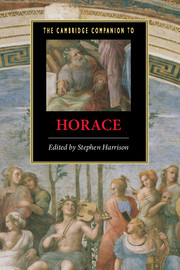7 - The Epodes: Horace’s Archilochus?
from Part 2: - Poetic Genres
Published online by Cambridge University Press: 28 May 2007
Summary
Horace’s Epodes were composed in approximately 42-30 bce, during Rome’s bloody transition from republic to autocracy. Dramatically speaking, the book is set in the run-up to the battle of Actium on 2 September 31 bce. The Epodes were for many years the least regarded of Horace’s works. Reasons include a tendency to focus on a few explicitly historical pieces (1, 7, 9, 16) to the relative exclusion of the rest, and a prudish distaste for the explicit sexuality of Epodes 8 and 12. In the last two decades, however, there has been a reawakening of interest in these difficult and fascinating poems, with Satires I the earliest of Horace’s works. Three commentaries have appeared since 1992 and there have been a number of important general studies. The current trend is to read the Epodes holistically, that is to say as an integral body of verse. This represents a reaction to sometimes over-schematic attempts to divide the book up into balancing pairs and the above-mentioned tendency to privilege the 'serious' poems at the expense of the lighter, more occasional pieces. But the pendulum has perhaps swung too far in the other direction. To embrace a holistic reading is to underplay the polymorphous diversity of the collection – in this respect a direct inheritor of Callimachus’ Iamboi – and to risk enshrining as
- Type
- Chapter
- Information
- The Cambridge Companion to Horace , pp. 93 - 104Publisher: Cambridge University PressPrint publication year: 2007
- 3
- Cited by

